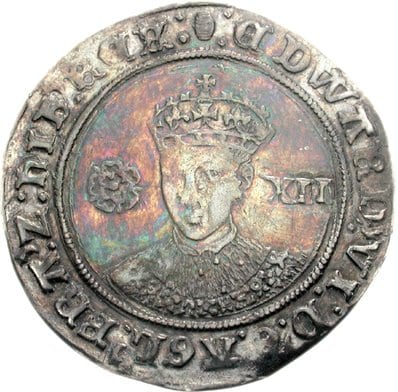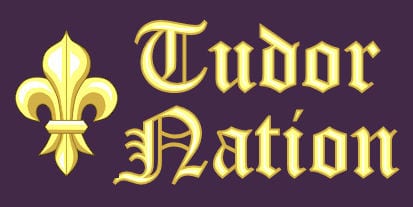Tudor money was in the form of coins and there were no paper notes. At the beginning of the Tudor period, the coins in existence were: a silver penny, a groat which was worth four pennies and an Angel which was worth 120 pennies or ten shillings.
Tudor Coinage

A pound was not a coin but had a value of 240 pennies or one pound weight of silver. Half-pennies were made by cutting a penny in half. A farthing was a quarter of a penny, made by cutting a penny into quarters. In similar fashion, two pence could be made by cutting a groat in half and a Half-Angel was half an Angel coin.
The Gold Sovereign and Gold Half-Sovereign coins were introduced in 1489. They were largely made as a diplomatic show of wealth and not really used for purchasing.
In 1503 Henry VII introduced a new coin, the silver shilling. It was originally called a testoon – the name was derived from the Italian testone, meaning headpiece. It featured a real portrait on the King rather than a representative likeness. The shilling was worth 12 pennies.
In August 1526, during the reign of King Henry VIII, a new coin, the Crown, was introduced. Made from gold, it had a value of four shillings and sixpence. However this was deemed an awkward valuation and it was replaced in October 1526 by a new gold Crown worth five shillings. A gold Half-Crown, with a value of two shillings and sixpence was also introduced.
In 1551, during the reign of Edward VI, a silver threepenny piece coin and a silver sixpence were introduced. The gold Crown and Half-Crown, introduced during his father’s reign were now made out of silver.
The Royal Mint

Coins were produced by the Royal Mint. The main Mint was located at the Tower of London, between the outer and inner walls of the fortress. This offered good protection and ensured maximum security for the coin of the Realm. There were also provincial mints in Canterbury, York, Durham
Throughout the Tudor period coins were made manually. Metal was placed between two dies and then hit firmly with a hammer so that the impressions were made into the metal.
Coin Clipping
Coin clipping was a process used by the government to reduce the value of coins. Small amounts of metal would be clipped or shaved off the coin. Once melted down it could be used to make more coins.
It was a crime for anyone other than the government to clip coins, nevertheless organised gangs did take metal from coins to produce counterfeit coins or to melt into bars of gold and silver which they would then sell.
In 1556 a new law was introduced requiring coins to be weighed before being accepted as payment. Those that fell short were to be cut in half so that they could not be used.
Wages
There was a massive discrepancy between the yearly income of the rich and that of the poor. The figures below are average yearly incomes for different groups of people. The figures in brackets are the comparative value today (2020).
A nobleman would earn around £2,000 (842,000)
A merchant or skilled artisan would earn around £100 (£42,000)
A clergyman could expect to be paid £20 (£8,500)
A labourer or farm worker would earn around £8 (£3,500)
Purchasing Power

In 1540, £20 would buy 4 horses, or 16 cows, or 860 lbs (pounds) of wool
The comparative value today of £20 is £8,500.
Today a horse costs approximately £4,000, a cow costs about £1,500 and wool costs about £5 per lb (pound)
Credit
Before the Tudor period, making a loan of money that would be paid back at a profit was termed ‘usury’ and forbidden by the Roman Catholic Church. Money could still be lent, but no interest was allowed to be charged.
The rise of Humanism saw many traditional values reassessed and a number of measures were deemed acceptable by the Church. A system of exchange rates could be used whereby, for example, silver could be exchanged for gold and a fee charged for the transaction. Similarly, bankers could issue a bill of credit which they would promise to pay and charge a fee for doing so.
The Reformation of the sixteenth century also brought a change in thinking with many Protestants disagreeing that usury was a crime. It was thought that if a man lent money to another man who then made a profit on that money, then the original lender was entitled to a share of that profit.
Charles du Moulin, a French theologian, felt that loans actually helped to improve society since new businesses could be started which in turn would provide more jobs for people. It was relatively easy for the upper classes to gain credit but the poor were more likely to be turned away. King Henry VIII and Elizabeth I both introduced a fixed interest rate as a way of preventing money lenders from charging more than 10% interest.
Published May 30, 2020 @ 6:15 pm – Updated –
Harvard Reference for Tudor Money and Finance:
Heather Y Wheeler. (2020 – 2024). Tudor Money and Finance Available: https://www.tudornation.com/tudor-money-and-finance Last accessed [date]


I see from your article that the silver sixpence was introduced in the reign of Edward VI but in CJ Sansom’s novels set in Henry VIII’s time the main character, Matthew Shardlake, sometimes gives a sixpence to a beggar or someone providing a small service. Did Sansom get it wrong?